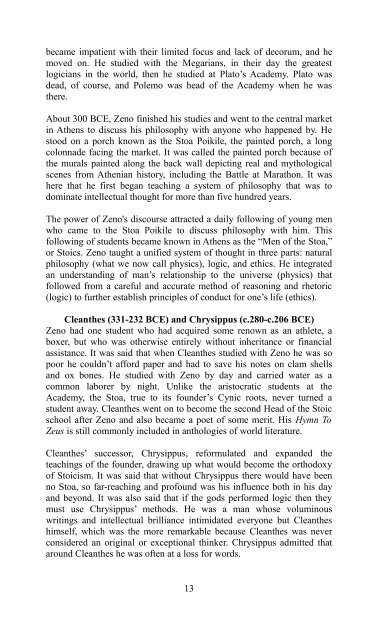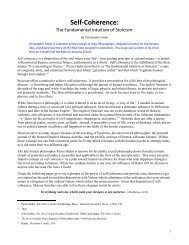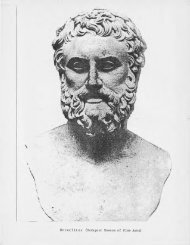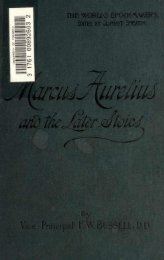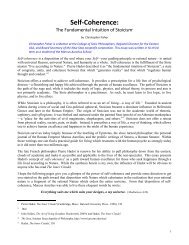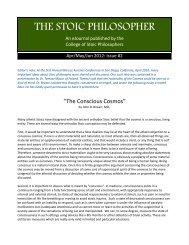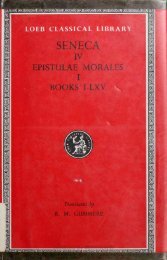The Stoic HANDBOOK - College of Stoic Philosophers
The Stoic HANDBOOK - College of Stoic Philosophers
The Stoic HANDBOOK - College of Stoic Philosophers
You also want an ePaper? Increase the reach of your titles
YUMPU automatically turns print PDFs into web optimized ePapers that Google loves.
ecame impatient with their limited focus and lack <strong>of</strong> decorum, and he<br />
moved on. He studied with the Megarians, in their day the greatest<br />
logicians in the world, then he studied at Plato’s Academy. Plato was<br />
dead, <strong>of</strong> course, and Polemo was head <strong>of</strong> the Academy when he was<br />
there.<br />
About 300 BCE, Zeno finished his studies and went to the central market<br />
in Athens to discuss his philosophy with anyone who happened by. He<br />
stood on a porch known as the Stoa Poikile, the painted porch, a long<br />
colonnade facing the market. It was called the painted porch because <strong>of</strong><br />
the murals painted along the back wall depicting real and mythological<br />
scenes from Athenian history, including the Battle at Marathon. It was<br />
here that he first began teaching a system <strong>of</strong> philosophy that was to<br />
dominate intellectual thought for more than five hundred years.<br />
<strong>The</strong> power <strong>of</strong> Zeno's discourse attracted a daily following <strong>of</strong> young men<br />
who came to the Stoa Poikile to discuss philosophy with him. This<br />
following <strong>of</strong> students became known in Athens as the “Men <strong>of</strong> the Stoa,”<br />
or <strong>Stoic</strong>s. Zeno taught a unified system <strong>of</strong> thought in three parts: natural<br />
philosophy (what we now call physics), logic, and ethics. He integrated<br />
an understanding <strong>of</strong> man’s relationship to the universe (physics) that<br />
followed from a careful and accurate method <strong>of</strong> reasoning and rhetoric<br />
(logic) to further establish principles <strong>of</strong> conduct for one’s life (ethics).<br />
Cleanthes (331-232 BCE) and Chrysippus (c.280-c.206 BCE)<br />
Zeno had one student who had acquired some renown as an athlete, a<br />
boxer, but who was otherwise entirely without inheritance or financial<br />
assistance. It was said that when Cleanthes studied with Zeno he was so<br />
poor he couldn’t afford paper and had to save his notes on clam shells<br />
and ox bones. He studied with Zeno by day and carried water as a<br />
common laborer by night. Unlike the aristocratic students at the<br />
Academy, the Stoa, true to its founder’s Cynic roots, never turned a<br />
student away. Cleanthes went on to become the second Head <strong>of</strong> the <strong>Stoic</strong><br />
school after Zeno and also became a poet <strong>of</strong> some merit. His Hymn To<br />
Zeus is still commonly included in anthologies <strong>of</strong> world literature.<br />
Cleanthes’ successor, Chrysippus, reformulated and expanded the<br />
teachings <strong>of</strong> the founder, drawing up what would become the orthodoxy<br />
<strong>of</strong> <strong>Stoic</strong>ism. It was said that without Chrysippus there would have been<br />
no Stoa, so far-reaching and pr<strong>of</strong>ound was his influence both in his day<br />
and beyond. It was also said that if the gods performed logic then they<br />
must use Chrysippus’ methods. He was a man whose voluminous<br />
writings and intellectual brilliance intimidated everyone but Cleanthes<br />
himself, which was the more remarkable because Cleanthes was never<br />
considered an original or exceptional thinker. Chrysippus admitted that<br />
around Cleanthes he was <strong>of</strong>ten at a loss for words.<br />
13


